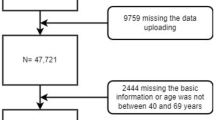Abstract
Background and Aims
Obesity is one of the main risk factors for gastric cardia adenocarcinoma (GCA) in the West. Also, recent studies have suggested that GCA is distinct from distal stomach tumor, with differing risk factors, tumor characteristics, and biological behavior. The objective of our research was to evaluate the relationship between obesity and GCA compared to non-cardia adenocarcinoma.
Materials and Methods
A total of 298 patients who were diagnosed with gastric adenocarcinoma and underwent surgery at Seoul National University Bundang Hospital were evaluated. Ninety-one cases were GCA, and 207 cases were non-cardiac adenocarcinoma. Obesity was estimated by body mass index (BMI, kg/m2). The degree of obesity was determined by using BMI <18.5, 18.5–23.9, 24–27.9, and ≥28 (kg/m2) as the cut-off points for underweight, normal weight, overweight, and obese, respectively. Association with obesity was estimated by odds ratio (OR) and 95% confidence interval (CI).
Results
Obesity was more prevalent in patients with GCA at the time of diagnosis for gastric cancer. Among obese persons with a BMI of 28 kg/m2 or higher, the OR was 3.937 (95% CI, 1.492–10.389; p = 0.006) for GCA compared to non-cardia adenocarcinoma. For overweight individuals, the OR was 2.194 (95% CI, 1.118–4.305; p = 0.022). Multivariate analysis of age, Helicobacter pylori infection, smoking, stage, and BMI with logistic regression was performed. BMI was an independent risk factor for GCA (OR, 1.123; 95% CI, 1.037–1.217; p = 0.004).
Conclusion
Obesity was more prevalent in patients with GCA compared to that in patients with gastric non-cardia adenocarcinoma. Also, BMI was an independent risk factor for GCA.

Similar content being viewed by others
References
Vial M, Grande L, Pera M. Epidemiology of adenocarcinoma of the esophagus, gastric cardia, and upper gastric third. Recent Results Cancer Res. 2010;182:1–17.
Lagergren J, Bergstrom R, Lindgren A, Nyren O. Symptomatic gastroesophageal reflux as a risk factor for esophageal adenocarcinoma. N Engl J Med. 1999;340:825–831.
Terry P, Lagergren J, Wolk A, Nyren O. Reflux-inducing dietary factors and risk of adenocarcinoma of the esophagus and gastric cardia. Nutr Cancer. 2000;38:186–191.
Oberg S, DeMeester TR, Peters JH, et al. The extent of Barrett’s esophagus depends on the status of the lower esophageal sphincter and the degree of esophageal acid exposure. J Thorac Cardiovasc Surg. 1999;117:572–580.
Chow WH, Blot WJ, Vaughan TL, et al. Body mass index and risk of adenocarcinomas of the esophagus and gastric cardia. J Natl Cancer Inst. 1998;90:150–155.
Vaughan TL, Davis S, Kristal A, Thomas DB. Obesity, alcohol, and tobacco as risk factors for cancers of the esophagus and gastric cardia: adenocarcinoma versus squamous cell carcinoma. Cancer Epidemiol Biomarkers Prev. 1995;4:85–92.
Deans C, Yeo MS, Soe MY, Shabbir A, Ti TK, So JB. Cancer of the gastric cardia is rising in incidence in an Asian population and is associated with adverse outcome. World J Surg. 2011;35:617–624.
Peleteiro B, Cavaleiro-Pinto M, Barros R, Barros H, Lunet N. Is cardia cancer aetiologically different from distal stomach cancer? Eur J Cancer Prev. 2011;20:96–101.
Xue L, Zhang X, Li Y, et al. Differences of immunophenotypic markers and signaling molecules between adenocarcinomas of gastric cardia and distal stomach. Hum Pathol. 2011;42:594–601.
Lehmann K, Schneider PM. Differences in the molecular biology of adenocarcinoma of the esophagus, gastric cardia, and upper gastric third. Recent results in cancer research. Fortschritte der Krebsforschung. Progres dans les recherches sur le Cancer. 2010;182:65–72.
Peters CJ, Hardwick RH, Vowler SL, Fitzgerald RC. Generation and validation of a revised classification for oesophageal and junctional adenocarcinoma. Br J Surg. 2009;96:724–733.
Maeda H, Okabayashi T, Nishimori I, et al. Clinicopathologic features of adenocarcinoma at the gastric cardia: is it different from distal cancer of the stomach? J Am Coll Surg. 2008;206:306–310.
Dawsey SM, Mark SD, Taylor PR, Limburg PJ. Gastric cancer and H. pylori. Gut. 2002;51:457–458.
Enroth H, Kraaz W, Rohan T, Nyren O, Engstrand L. Does the method of Helicobacter pylori detection influence the association with gastric cancer risk? Scand J Gastroenterol. 2002;37:884–890.
Shin A, Shin HR, Kang D, Park SK, Kim CS, Yoo KY. A nested case-control study of the association of Helicobacter pylori infection with gastric adenocarcinoma in Korea. Br J Cancer. 2005;92:1273–1275.
Zhou BF. Predictive values of body mass index and waist circumference for risk factors of certain related diseases in Chinese adults–study on optimal cut-off points of body mass index and waist circumference in Chinese adults. Biomed Environ Sci. 2002;15:83–96.
Zhou BF. Effect of body mass index on all-cause mortality and incidence of cardiovascular diseases–report for meta-analysis of prospective studies open optimal cut-off points of body mass index in Chinese adults. Biomed Environ Sci. 2002;15:245–252.
Abnet CC, Freedman ND, Hollenbeck AR, Fraumeni JF Jr, Leitzmann M, Schatzkin A. A prospective study of BMI and risk of oesophageal and gastric adenocarcinoma. Eur J Cancer. 2008;44:465–471.
Kubo A, Corley DA. Body mass index and adenocarcinomas of the esophagus or gastric cardia: a systematic review and meta-analysis. Cancer Epidemiol Biomarkers Prev. 2006;15:872–878.
Ryan AM, Rowley SP, Fitzgerald AP, Ravi N, Reynolds JV. Adenocarcinoma of the oesophagus and gastric cardia: male preponderance in association with obesity. Eur J Cancer. 2006;42:1151–1158.
Mattioli S, Ruffato A, Di Simone MP, et al. Immunopathological patterns of the stomach in adenocarcinoma of the esophagus, cardia, and gastric antrum: gastric profiles in Siewert type I and II tumors. Ann Thorac Surg. 2007;83:1814–1819.
Qiu HB, Zhang LY, Keshari RP, et al. Relationship between H. Pylori infection and clinicopathological features and prognosis of gastric cancer. BMC Cancer. 2010;10:374.
Ramos CM, Boleo-Tome C, Monteiro-Grillo I, Camilo M, Ravasco P. The diversity of nutritional status in cancer: new insights. Oncologist. 2010;15:523–530.
Conflict of interest
None.
Author information
Authors and Affiliations
Corresponding author
Rights and permissions
About this article
Cite this article
Cho, Y., Lee, D.H., Oh, H.S. et al. Higher Prevalence of Obesity in Gastric Cardia Adenocarcinoma Compared to Gastric Non-Cardia Adenocarcinoma. Dig Dis Sci 57, 2687–2692 (2012). https://doi.org/10.1007/s10620-012-2095-6
Received:
Accepted:
Published:
Issue Date:
DOI: https://doi.org/10.1007/s10620-012-2095-6




